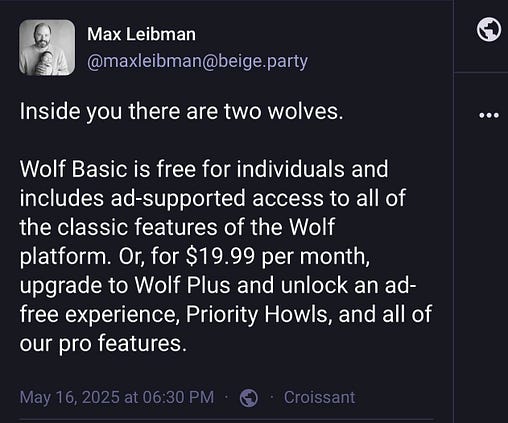🧠 Community Wisdom: Building great working relationships with different functions, strategy at B2B vs. B2C compan…
👋 Hello and welcome to this week’s edition of ✨ Community Wisdom ✨ a subscriber-only email, delivered every Saturday, highlighting the most helpful conversations in our members-only Slack community. A big thank-you to this month’s community sponsor, Merge. Merge makes integrating with your customers’ software vendors easy. Add hundreds of integrations to your B2B SaaS products, with unified APIs for file storage, ticketing, CRM, ATS, HRIS, and accounting. AI companies love Merge because it delivers instant, secure access to clean customer data that powers their solutions. Stop wasting countless engineering hours staying ahead of breaking API changes and digging through a backlog of integration support tickets. Merge handles the full integration lifecycle so you can focus on what matters most: building your core product! ✨ Upcoming community meetups ✨Upcoming community-organized meetups—click the city name to RSVP:
Can’t find your city and want to host one? Just DM @Riya in our Slack. It takes 10 minutes (i.e. pick a date and location), and you get to meet awesome people from our community. Learn more here. 🎙️ New podcast episodes this weekMicrosoft CPO: If you aren’t prototyping with AI you’re doing it wrong | Aparna Chennapragada: YouTube // Apple // Spotify  How custom GPTs can make you a better manager | Hilary Gridley (Head of Core Product at Whoop): YouTube // Spotify // Apple  Unconventional product lessons from Binance, N26, Google, more | Mayur Kamat (CPO at N26, ex-Binance Head of Product): YouTube // Apple // Spotify  💥 Top threads this week1. Building great working relationships with different functions
James Conway: This is what I have tried; your mileage may vary...
Joshua Herzig-Marx: 1. Be reliable. 2. Be kind. 3. Be curious. 4. Genuinely like the people with whom you work. Gary:
James Conway: @Joshua Herzig-Marx... and if you find that some of the people you’ll need to work with are very difficult to like? Joshua Herzig-Marx: If you can’t bring yourself to like them even a bit, it’s going to be hard to have a great working relationship. It’s worthwhile thinking of “liking people” as being a skill that you possess, rather than “likeability” as an intrinsic quality they possess. gary: reading the book “the courage to be disliked” gave me a fresh perspective on managing/developing relationships. Joshua Herzig-Marx: Say more about the book? gary: some key points:
Lee: Jumping in with a few more that have helped me:
Nitin Mehta: Great inputs and will check the book, @gary, to get more info. Thanks for the awesome insights. Takeaways:
@Lee —Great nuggets. Thank you for sharing—they all really resonate. Would you also elaborate/give examples of these two, por favor:
Kiyani:
Also, to add on to what @Joshua Herzig-Marx said about likability, here is a quote I totally agree with. Preston Sharp: Hi, Jeff. Just the fact that you are asking this question is a great indication that you are on the right track. Kudos! I love the comments from Suraj, Jim, and Likitha. Great points. From a team leader’s perspective, one of the things I appreciate the most when someone joins my team is curiosity and a willingness to ask questions. It shows they are trying to understand, trying to connect dots, and building rapport with others. That gives me confidence that at some point it will all begin to click… But not all managers want you asking questions; they might prefer you figure things out on your own. In my humble opinion, learning (the context/history, preferences, priorities, company culture) should be your top priority at this early stage. In addition, on a team that size, there are likely many opportunities to help out on a broad range of priorities. While your product is your priority, it doesn’t mean you can’t help in other ways. Volunteering to help on other needs, especially those that don’t require a huge time commitment, can be a great way to feel like you are getting those quick wins and for others to see your added value. (I also love nothing more than when someone comes to me, seeing that I’ve got a lot on my plate, and asks how they can help. In this case, even if you don’t end up helping, they see that you are being proactive and a team player.) 2. Strategy at B2B vs. B2C companies
James Conway: First thing that occurred to me were the elements of value in B2C vs. B2B... https://www.bain.com/insights/the-elements-of-value-hbr/ https://www.bain.com/insights/the-b2b-elements-of-value-hbr/. If you understand the value your customer is seeking, that influences your strategy. My instinct is that there are likely more elements of value considered in a B2B sale compared to B2C because there are commonly lots of people on the buy side in B2B, whereas B2C is generally one person or at most a family. Kevin Kononenko: I’ll give you 3 good ones by Ibrahim Bashir that cover a variety of subjects. Each one links out to a bunch of relevant posts: That list should cover it well. Matt Gonzales: I’m not an expert on this question and I have no experience in B2C (B2B only), so this is just my hot take/opinion (no data or framework). B2B strategy is usually centered on delivering value to the business, but the product or service is used by people. So in B2B you’re still marketing to and building for individuals, but the decision to buy, how much to spend, and what they need from the product or service is largely controlled by the business they work for (budget, requirements) and their professional capacity/role (“What will help me deliver more impact in my role or do my role easier?”). The buyer is also often different from the user (broad-stroke statement because overlap exists). B2C seems to be focused on marketing to and building directly for an individual who has full control over their budget and requirements. They’re typically not making a decision to support other stakeholders. They are the sole decision-maker/buyer and user. I assume there’s more consideration for the psychology of product value and usage vs. B2B, but I have no data to support this. Maybe the TL;DR: B2B
B2C
Again: I’m not an expert here, I just like the question and figured I’d join in the conversation, so I know I’ve missed some really critical pieces here. David Krell: I’ve done both, and they are completely different. Matt’s points above are right. IMO the biggest difference is there is often a delta in B2B between your buyer and end user. This creates added complexity, as you need to understand how the purchasing decision happens. Also, historically, this is why enterprise software 3. Moving from PC to Mac tips
Dustin Coates: I did that recently. I’d share Raycast, for sure. Plus an app for window management. This is something that Windows does so much better than Mac. Miroslav Pavelek: Both on Windows and on Mac I use Lightshot for screenshot. Other than that, nothing. I don’t think you need to have any tips to ease transition anyhow; I believe you shouldn’t mimic Windows flow in Mac but embrace Mac ways.
Joshua Herzig-Marx: I was this person! I hated using Mac for three years at Google, and since then I’ve been the weirdo at every startup with a PC. Here are the four things I did to make it tolerable:
Bonus advice: learn some Unix and get good at the command line! Marc: Take the time to explore Raycast commands and ecosystem. And whatever pain points you encounter (except a full Microsoft office), do an online search and, more often than not, an artisanal/OSS app exists that will solve it and improve your Mac experience by a few %. If you’re keen on micro optimisations/automation, take a look at BetterTouchTool and Keyboard Maestro. Setapp is also a great way to access all sorts of quality apps for an affordable monthly subscription. Joshua Herzig-Marx: (Does it bother anyone else that “The secret to using Mac OS successfully is adding one or more background services”?) Miroslav Pavelek: @Joshua Herzig-Marx So are you telling us that you do not install anything on the Windows? Joshua Herzig-Marx: Honestly? Not much. I have one major one: to tweak the taskbar (tighten icon spacing, suppress window title for some apps). And I have a special screenshot tool because I often want to add drop shadows. Ashwin: It’s been many years since I’ve had to use a Windows laptop, but I would say the biggest thing for me was minimizing and maximizing of different screens on a Mac. Guy Peled: Great stuff from everybody so far! @Joshua Herzig-Marx, thanks to your message, I just found out about <option>+Click on the green dot to maximize a window without going full screen. The problem when I go full screen is that the window creates a new space and doesn’t show up in Mission Control. Mission Control is my main way to switch apps (I use the top-left corner as a hot corner to trigger it). How do you switch apps? Do you just go full screen with your main apps and then know to find them at the top while in Mission Control? Joshua Herzig-Marx: Does alt-tab (command-tab? I forget the Mac keyboard) not work when full screen? Guy Peled: It does, but using the hot corner for Mission Control and then clicking on the relevant app is quicker than toggling between apps via <command>+<tab>. Also, <command>+<tab> doesn’t work like it does on a PC, where if you have multiple windows of the same app, it includes them as part of the toggle. On Macs, it shows just one icon per app when using <command>+<tab>, even if there are multiple windows open. Mission Control, on the other hand, shows all windows of all apps. Joshua Herzig-Marx: Oh that’s right. One of the many annoyances I’d forgotten about. Marc:
Ashley Rolfmore:
(If you’re a devvy type and/or are used to Linux, I also have a bunch of tips. Happy to share, but the question specifically mentioned Windows.) Matt: Learn a handful of useful keyboard shortcuts Like command + L when using Safari to go to the URL bar etc. I’ve got around ten I use all the time and have known them for 15+ years and they make my life much easier. Marc: Also the Help menu as a search bar, which actually allows to search and trigger any action from the menu bar of the app you’re in. Great way to locate a command/see the associated keyboard shortcut. Some third-party apps do the same in a command panel menu, which makes it even more convenient (Finbar, Paletro, Raycast, etc.). 4. Understanding “solutions consultants”
Sarah Elkins: This role has been pretty common in every industry I’ve worked in. If it’s primarily supporting the sales process, then I’ve often seen it called a pre-sales engineer or a solutions engineer. I’ve seen the Solutions Consultant title used more in a post-sales role that sits in customer success. The pre-sales engineers usually sit in the sales org but know the product very well. They’re often the ones doing the demo and showing how to specifically set up the product to the prospect’s specific requirements and answer all the technical questions. They often provide a lot of feedback to the product team but don’t do other product management tasks like setting product requirements, feature prioritization, roadmaps etc. May Zhou: I’ve interacted with a few solutions consultants from Figma, specifically for Dev Mode, and they def have extended knowledge of the product in order to do demos and answer questions from clients. Miroslav Pavelek: I’ve had a similar experience to @Sarah Elkins. I’m used to (pre)sales engineers working closely with one or more “true” Sales reps. Their role is to support Sales throughout the process—preparing technical materials, answering RFPs, and delivering technical presentations. Unless they’re leading deep technical integrations or directly influencing the roadmap, I’d place them in the Sales department. And to your point: “If the role lives in sales, they won’t know the product and we may have wasted these resources.” A good Sales Engineer must understand the product deeply, regardless of where they sit. Being in Sales doesn’t block access to technical or product knowledge—it just focuses their expertise on client-facing use cases and how to approach them using current products. Adrian Pilarczyk: Not sure if this is relevant, but I work as a Solution Architect for Saleor, which is a commerce engine with cloud offering. I would say my role is pretty standard for this type of company. Before that, I worked as Developer Advocate and Fullstack Developer at Saleor, so I like to think I have both a customer-centric and product-centric point of view. But we’ve recruited outside people for this role as well. In our structure, product managers/owners are not involved in sales directly, but they support the process. We also maintain a tight feedback loop with the product team, often surprising them in solutions we build using software they’ve built. If you have any questions, I would be happy to answer. Aayush Damani: I was a solutions consultant in my past life at Siemens. These roles make sense once a company grows to a level where you have multiple big fishes to cater to and PMs won’t have enough time to cater to all of them. Dustin Coates: I’ve been in an org before where Solutions lived in both Product and Sales at different times. I came away with the belief that they definitely should live within Sales, although you need to set up training and regular connections with Product. They need to know the product inside and out, but ultimately their goal is to (help) close, and being in Sales aligns with that. Ritesh: I’ve been a pre-sales engineer/solutions consultant for a large part of my career, for large services vendors. My role was to take individual products (sometimes from different vendors), treat them as items on a buffet, and then craft them into multi-course dining experience, plate by plate, cutlery included. It was not just about positioning features/products but architecting end-to-end solutions, a skill set that evolved into product management later, as it allowed me to look at a client’s larger environment rather than just what pain point my product could fix. 5. Hiring interns
Daniel Heo-Lu: Would love to hear more detail on what they are struggling with, including what instructions, context or guidance you have given them and what expectations you have and where are they falling short. Greg Docter: This is too harsh but directionally correct—get rid of the interns. “No revenue yet, every day is crucial.” Time spent managing interns is basically time wasted. Ilya Subkhankulov: This is unfortunate, but interns and early-stage startups don’t mix well. Interns are typically a net cost on any organization and require training. Miroslav Pavelek: Same as above. Only other approach is give them ownership over work when anything is better than nothing. Akos Tolnai: The way it started clicking for us was to:
🤓 Top finds
😂 Meme of the weekHave a fulfilling and productive week 🙏 If anyone in your life would benefit from this newsletter or community, consider giving them a gift subscription 💞 There are group discounts, gift options, and referral bonuses available. Sincerely, Kiyani 👋 Invite your friends and earn rewardsIf you enjoy Lenny's Newsletter, share it with your friends and earn rewards when they subscribe. |
Similar newsletters
There are other similar shared emails that you might be interested in:
- 🧠 Community Wisdom: Essential reading for early-stage founders, balancing unlimited SaaS plans with profitability…
- 🧠 Community Wisdom: Finding your voice on established teams, focus tips for ADHD brains, how to best use Granola,…
- 🧠 Community Wisdom: Designing great performance review templates, balancing oversight and autonomy with junior te…


